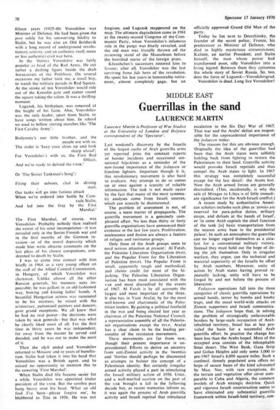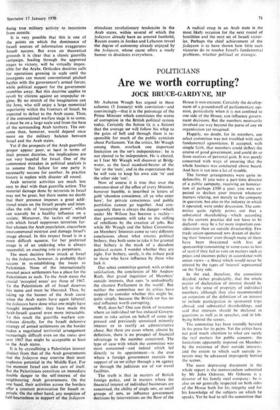MIDDLE EAST
Guerrillas in the sand
LAURENCE MARTIN
Laurence Martin is Professor of War Studies at the University of London and Defence correspondent of the 'Spectator'.
Last weekend's discovery by the Israelis of the largest cache of Arab guerrilla arms yet reported joins the constant reports of border incidents and occasional sen- sational hijackings as a reminder of the new-found importance of the fedayeen or freedom fighters. Important though it is, this revolutionary movement is also hard to evaluate. Any attempt to do so comes up at once against a scarcity of reliable information. The task is not made easier by the fact that many of the most systema- tic analyses come from Israeli sources, which can scarcely be disinterested. yet reported joins the constant reports of border incidents and occasional sen- sational hijackings as a reminder of the new-found importance of the fedayeen or freedom fighters. Important though it is, this revolutionary movement is also hard to evaluate. Any attempt to do so comes up at once against a scarcity of reliable information. The task is not made easier by the fact that many of the most systema- tic analyses come from Israeli sources, which can scarcely be disinterested.
The problem of assessment is not, of course, a mere matter of propaganda. The guerrilla movement is a genuinely com- plicated affair. No less than thirty or forty guerrilla organisations have announced their existence in the last few years. Proliferation, coalescence and fission are always a feature of refugee and resistance groups.
Only three of the Arab groups seem to need serious attention at present: Al Fatah, the Palestine Liberation Organisation (PLO), and the Popular Front for the Liberation of Palestine (PFLP). The Popular Front is small, apparently tough and methodical, and claims credit for most of the hi- jacking. The Palestine Liberation Organ- isation has been most associated with the UAR and most discredited by the events of 1967. Al Fatah is by all accounts the largest and most important of the three. It also has, in Yasir Arafat, by far the most well-known and charismatic of the Pales- tinian leaders. By gaining a political foothold in the PLO and being elected last year as chairman of the Palestine National Council, a representative assembly of all the Palestin- ian organisations except the PFLP, Arafat has a clear claim to be the leading per- sonality of the resistance movements.
These movements are far from new, though their present importance is un- precedented. Efforts to derive an ancestry from anti-Zionist activity in the 'twenties and 'thirties should perhaps be discounted as attempts to bolster the concept of a Palestinian identity. But certainly irregular armed activity played a part in stimulating the Israeli military action of 1956. UN F, and a well-merited caution on the part of the UAR brought a lull in the following decade but, as recent memories inform us, it was again the process of Arab guerrilla activity and Israeli reprisal that stimulated
escalation to the Six Day War of 1967. That war and the Arabs' defeat are respon: sible for the unprecedented importance of the fedayeen today.
The reasons for this are obvious enough. Originally the idea of the guerrillas had been that the Arab states were selfishly holding back from fighting to restore the Palestinians to their land. Guerrilla activity would provoke Israeli reprisals and thus compel the Arab states to fight. In 1967 this strategy was completely successful except for the last detail: the Arabs lost. Now the Arab armed forces are generally discredited. (This, incidentally, is why the sale of Mirages to Libya is of little immedi- ate significance for the Arab-Israeli conflict.) A recent study by authoritative Ameri- can scholars includes such jibes as 'armies are reserved for para-police duties; military coups, and defeats at the hands of Israel', or 'in some Arab capitals the chief function of the tank [is] basic transportation from the nearest army base to the presidential palace'. In such an atmosphere the guerrillas can no longer regard themselves as a cata- lyst for a conventional military victory. Instead they must hold out the hope of do- ing the job themselves. Only in irregular warfare, they argue, can the technical and material superiority of the Israelis be offset by Arab numbers. Moreover, unity of action by Arab states having proved re- peatedly lacking, unity will have to be forged by and not before the process of liberation.
Fedayeen operations fall into the three categories of classic guerrilla operations by armed bands, terror by bombs and booby traps, and the usual world-wide attacks on Zionist supporters and Israeli communica- tions. The fedayeen hope that, in solving the problem of strategically unfavourable borders by large-scale occupation of Arab- inhabited territory, Israel has at last pro- vided the basis for a successful Arab guerrilla effort. In practice the change has been less than the Arabs hoped. Most of the occupied area consists of the inhospitable Sinai desert. The West Bank, Gaza Strip and Golan Heights add only some 3,000 to pre-1967 Israel's 8,000 square miles. Such a confined, densely populated area offers no hope of secure bases of the kind advocated by Mao. Nor, with rare exceptions, do the terrain and vegetation offer cover com- parable to Cuba and Algeria, the common models of Arab strategic doctrine. Quick and vigorous Israeli counteraction seems to have eliminated any substantial guerrilla framework within Israeli-held territory, con- fining true military activity to incursions from outside.
It is very possible that this is one of the points on which the dominance of Israeli sources of information exaggerates Israeli success. But even on theoretical grounds it is clear that a classic guerrilla campaign, leading through the approved stages to victory, will be virtually impos- sible for the Arabs. Orthodox doctrine calls for operations growing in scale until the insurgents can mount conventional pitched battles with the government's armed forces, while political support for the government crumbles away. But this doctrine applies to revolt by citizens against an unpopular re- gime. By no stretch of the imagination can the Jews, who still enjoy a large numerical superiority within the frontiers of Israel, be expected to defect to the Arab cause. Thus, if the conventional warfare stage is to come. it must be on a large scale and from the base of the surrounding Arab territory. The out- come then, however, would depend once more on the military balance between Israel and the Arab states.
Yet if the prospects of the Arab guerrillas proper appear poor, at least in terms of their present doctrine, the implications are not very hopeful for Israel. One of the commonest mistakes in political analysis is to assume that failure for one party is necessarily success for another. In practice history is replete with disaster all round.
Arab terrorist activities are much less easy to deal with than guerrilla action. The material damage done by terrorists in Israel may not be great, but there seems no doubt that their presence imposes a great addi- tional strain on the Israeli people and inten- sifies the role of 'occupying power', which can scarcely be a healthy influence on a society. Moreover, the tactics of reprisal with which Israel suppresses terrorism fur- ther alienate the Arab population, exacerbate intercommunal mistrust and damage Israel's image abroad. In this respect Israel is in a more difficult squeeze, for her preferred image is of an underdog who is always successful; an exacting role to perpetuate.
The most decisive blow struck at Israel by the fedayeen, however, is probably their success in re-establishing the issues as Palestinian. None of the internationally mooted peace settlements has a place for the Palestinians as such. To the Arab states the crucial 'occupied areas' are those of 1967. To the Palestinians all of Israel deserves this name and must be liberated. Thus, by taking up the banner of the Arab cause when the Arab states have again faltered, the fedayeen have done what one might have thought impossible: they have made the Arab-Israeli quarrel even more intractable. To this result the guerrilla warfare con- tributes directly, for the Israeli defensive strategy of armed settlements on the border makes a negotiated territorial arrangement increasingly difficult even on the status quo ante 1967 that might be acceptable at least to the Arab states.
It is by crystallising a Palestinian interest distinct from that of the Arab governments that the fedayeen may exercise their most explosive potential in the Middle East. For the moment Israel can take care of itself. But the Palestinians constitute an immediate double danger to the self-interest of the neighbouring Arab governments. On the one hand, their activities across the borders offer a constant provocation for Israeli re- prisals. On the other hand, any suspicion of half-heartedness in support of the fedayeen stimulates revolutionary tendencies in the Arab states, within several of which the fedayeen already have an assured foothold4 Recent events in Jordan and Lebanon reveal the degree of autonomy already enjoyed by the fedayeen, whose cause offers a ready banner to dissidents everywhere. A radical coup in an Arab state is the most likely occasion for the next round of hostilities and the next set of Israeli victor- ies. Perhaps the chief achievement of the fedayeen is to have shown how little such victories do to resolve Israel's fundamental problems, whether political or strategic.



































 Previous page
Previous page